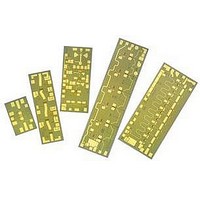AMMC-6140-W50 Avago Technologies US Inc., AMMC-6140-W50 Datasheet - Page 4

AMMC-6140-W50
Manufacturer Part Number
AMMC-6140-W50
Description
IC MMIC FREQ MULT DUAL 20-40GHZ
Manufacturer
Avago Technologies US Inc.
Datasheet
1.AMMC-6140-W50.pdf
(6 pages)
Specifications of AMMC-6140-W50
Function
Frequency Multiplier
Supply Current
27mA
Supply Voltage Range
4.5V
Frequency Max
20GHz
Frequency Min
10GHz
Supply Voltage Max
7V
Gain
1dB
Lead Free Status / RoHS Status
Lead free / RoHS Compliant
Lead Free Status / RoHS Status
Lead free / RoHS Compliant, Lead free / RoHS Compliant
Available stocks
Company
Part Number
Manufacturer
Quantity
Price
Part Number:
AMMC-6140-W50
Manufacturer:
AVAGO/安华高
Quantity:
20 000
Biasing and Operation
The frequency doubler MMIC consists of a differential am-
plifier circuit that acts as an active balun. The outputs of
this balun feed the gates of balanced FETs and the drains
are connected to form the single-ended output. This
results in the fundamental frequency and odd harmon-
ics canceling and the even harmonic drain currents (in
phase) adding in superposition. Node ‘S’ acts as a virtual
ground. An input matching network (M/N) is designed to
provide good match at fundamental frequencies and pro-
duces high impedance mismatch at higher harmonics.
AMMC-6140 is biased with a single positive drain supply
and single negative gate supply using separate bypass
capacitors. It is normally biased with the drain supply
connected to the V
connected to the V
the 100 pF bypass capacitor and it should be placed as
close to the die as possible. Typical bias connections are
shown in Figure 12. For most of the application it is rec-
ommended to use a Vg= -1.2V and Vd=4.5V.
The AMMC-6140 performance changes very slightly with
Drain (Vd) and Gate bias (Vg) as shown in Figures 8 and
9. Minor improvements in performance are possible for
output power or fundamental suppression by optimizing
the Vg from -1.0V to -1.4V and/or Vd from 4.0 to 5.0V.
The RF input and output ports are AC coupled, thus no
DC voltage is present at either port. However, the RF
output port has an internal output matching circuit that
presents a DC short. Proper care should be taken while
biasing a sequential circuit to the AMMC-6140 as it might
cause a DC short (Use a DC block if sub sequential circuit
is not AC coupled). No ground wires are needed since
ground connections are made with plated through-holes
to the backside of the device.
Refer to the Absolute Maximum Ratings table for allowed
DC and thermal conditions.
4
M/N
@ fo
Active Balun
A. Diff. Amp
gg
DD
bond pad. It is important to have
bond pad and the gate supply
S
M/N
@ 2fo
Assembly Techniques
The backside of the MMIC chip is RF ground. For mi-
crostrip applications the chip should be attached directly
to the ground plane (e.g. circuit carrier or heatsink) using
electrically conductive epoxy
For best performance, the topside of the MMIC should be
brought up to the same height as the circuit surrounding
it. This can be accomplished by mounting a gold plate
metal shim (same length and width as the MMIC) under
the chip which is of correct thickness to make the chip
and adjacent circuit the same height. The amount of
epoxy used for the chip and/or shim attachment should
be just enough to provide a thin fillet around the bottom
perimeter of the chip or shim. The ground plane should
be free of any residue that may jeopardize electrical or
mechanical attachment.
The location of the RF bond pads is shown in Figure
12. Note that all the RF input and output ports are in a
Ground-Signal-Ground configuration.
RF connections should be kept as short as reasonable to
minimize performance degradation due to undesirable
series inductance. A single bond wire is normally suf-
ficient for signal connections, however double bonding
with 0.7 mil gold wire or use of gold mesh is recom-
mended for best performance, especially near the high
end of the frequency band.
Thermosonic wedge bonding is the preferred method
for wire attachment to the bond pads. Gold mesh can
be attached using a 2 mil round tracking tool and a tool
force of approximately 22 grams and a ultrasonic power
of roughly 55 dB for a duration of 76 ±8 mS. The guided
wedge at an untrasonic power level of 64 dB can be used
for 0.7 mil wire. The recommended wire bond stage tem-
perature is 150 ± 2°C.
Caution should be taken to not exceed the Absolute
Maximum Rating for assembly temperature and time.
The chip is 100 µm thick and should be handled with care.
This MMIC has exposed air bridges on the top surface and
should be handled by the edges or with a custom collet
(do not pick up the die with a vacuum on die center).
This MMIC is also static sensitive and ESD precautions
should be taken.
Notes:
1. Ablebond 84-1 LM1 silver epoxy is recommended.
2. Eutectic attach is not recommended and may jeopardize reliability
of the device
[1,2]
.



















